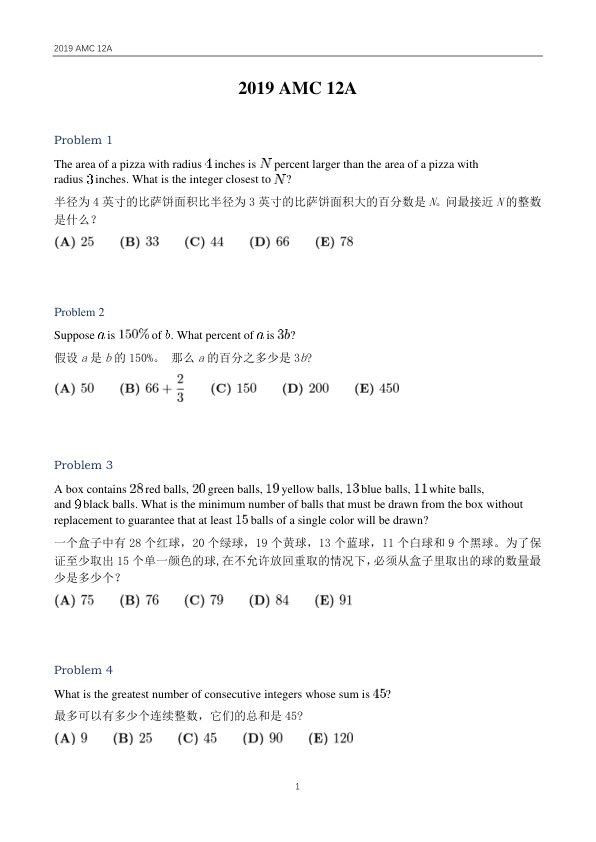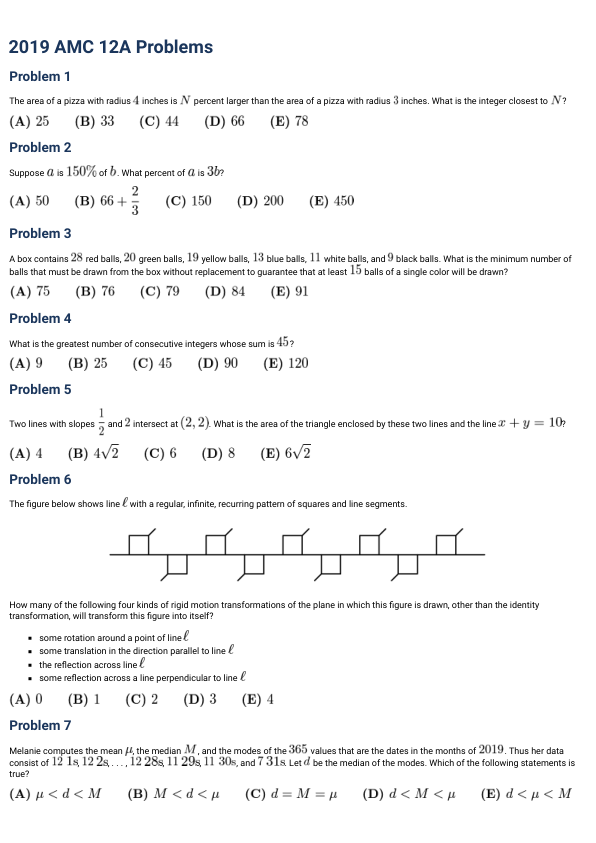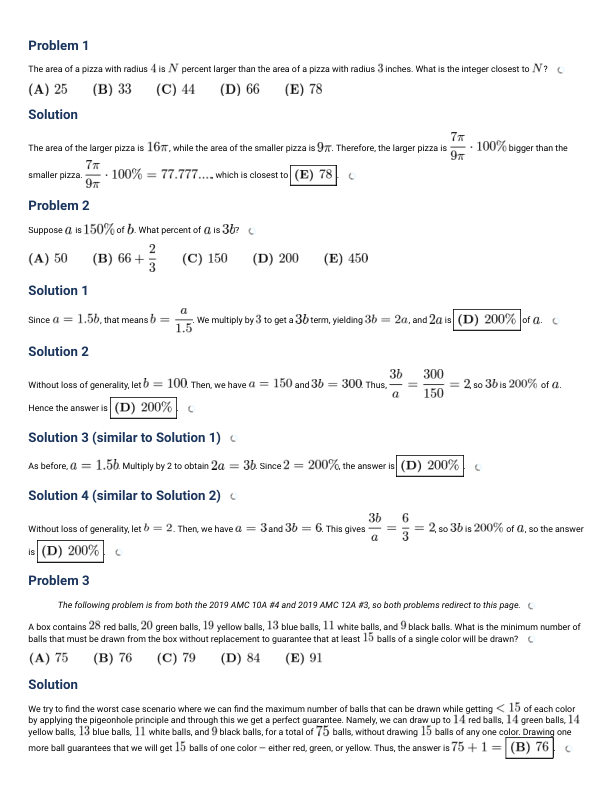2019 AMC amc12a 真题 答案 详解
| 序号 | 文件列表 | 说明 | ||
|---|---|---|---|---|
| 1 | 2019-amc12a-paper-eng-zh.pdf | 11 页 | 521.32KB | 中英双语真题 |
| 2 | 2019-amc12a-paper-eng.pdf | 4 页 | 249.21KB | 英文真题 |
| 3 | 2019-amc12a-key.pdf | 1 页 | 10.07KB | 真题答案 |
| 4 | 2019-amc12a-solution-eng.pdf | 36 页 | 2.24MB | 真题文字详解(英文) |
| 5 | 2019-amc12a-solution-eng-zh.pdf | 36 页 | 2.46MB | 真题文字详解(中英双语) |
| 6 | 2019-amc12a-solution-video-zh.mp4 | 27.34 分钟 | 60.89MB | 真题视频详解(普通话) |
中英双语真题
2019 AMC 12A
Problem 1
The area of a pizza with radius 4 inches is ( N ) percent larger than the area of a pizza with radius 3 inches. What is the integer closest to ( N )?
半径为4英寸的比萨饼面积比半径为3英寸的比萨饼面积大的百分数是( N )。问最接近( N )的整数是什么?
(A) 25 (B) 33 (C) 44 (D) 66 (E) 78
Problem 2
Suppose ( a ) is 150% of ( b ). What percent of ( a ) is ( 3b )?
假设( a )是( b )的150%。那么( a )的百分之多少是( 3b )?
(A) 50 (B) ( 66 + \frac{2}{3} ) (C) 150 (D) 200 (E) 450
Problem 3
A box contains 28 red balls, 20 green balls, 19 yellow balls, 13 blue balls, 11 white balls, and 9 black balls. What is the minimum number of balls that must be drawn from the box without replacement to guarantee that at least 15 balls of a single color will be drawn?
一个盒子里有28个红球,20个绿球,19个黄球,13个蓝球,11个白球和9个黑球。为了保证至少取出15个单一颜色的球,在不允许放回重取的情况下,必须从盒子里取出的球的数量最少是多少?
(A) 75 (B) 76 (C) 79 (D) 84 (E) 91
Problem 4
What is the greatest number of consecutive integers whose sum is 45?
最多可以有多少个连续整数,它们的总和是45?
(A) 9 (B) 25 (C) 45 (D) 90 (E) 120

英文真题
2019 AMC 12A Problems
Problem 1
The area of a pizza with radius 4 inches is ( N ) percent larger than the area of a pizza with radius 3 inches. What is the integer closest to ( N )?
(A) 25 (B) 33 (C) 44 (D) 66 (E) 78
Problem 2
Suppose ( a ) is 150% of ( b ). What percent of ( a ) is ( 3b )?
(A) 50 (B) ( 66 + \frac{2}{3} ) (C) 150 (D) 200 (E) 450
Problem 3
A box contains 28 red balls, 20 green balls, 19 yellow balls, 13 blue balls, 11 white balls, and 9 black balls. What is the minimum number of balls that must be drawn from the box without replacement to guarantee that at least 15 balls of a single color will be drawn?
(A) 75 (B) 76 (C) 79 (D) 84 (E) 91
Problem 4
What is the greatest number of consecutive integers whose sum is 45?
(A) 9 (B) 25 (C) 45 (D) 90 (E) 120
Problem 5
Two lines with slopes ( \frac{1}{2} ) and 2 intersect at ( (2, 2) ). What is the area of the triangle enclosed by these two lines and the line ( x+y=10 )?
(A) 4 (B) ( 4\sqrt{2} ) (C) 6 (D) 8 (E) ( 6\sqrt{2} )
Problem 6
The figure below shows line ( \ell ) with a regular, infinite, recurring pattern of squares and line segments.
How many of the following four kinds of rigid motion transformations of the plane in which this figure is drawn, other than the identity transformation, will transform this figure into itself?
- some rotation around a point of line ( \ell )
- some translation in the direction parallel to line ( \ell )
- the reflection across line ( \ell )
- some reflection across a line perpendicular to line ( \ell )
(A) 0 (B) 1 (C) 2 (D) 3 (E) 4
Problem 7
Melanie computes the mean ( \mu ), the median ( M ), and the modes of the 365 values that are the dates in the months of 2019. Thus her data consist of 12 1s, 12 2s, ..., 12 28s, 11 29s, 11 30s, and 7 31s. Let ( d ) be the median of the modes. Which of the following statements is true?
(A) ( \mu < d < M ) (B) ( M < d < \mu ) (C) ( d = M = \mu ) (D) ( d < M < \mu ) (E) ( d < \mu < M )

真题文字详解(英文)
Problem 1
The area of a pizza with radius $4$ is $N$ percent larger than the area of a pizza with radius $3$ inches. What is the integer closest to $N$?
(A) $25$ (B) $33$ (C) $44$ (D) $66$ (E) $78$
Solution
The area of the larger pizza is $16\pi$, while the area of the smaller pizza is $9\pi$. Therefore, the larger pizza is $\frac{7\pi}{9\pi} \cdot 100\%$ bigger than the smaller pizza. $\frac{7\pi}{9\pi} \cdot 100\% = 77.777...$, which is closest to (E) 78.
Problem 2
Suppose $a$ is $150\%$ of $b$. What percent of $a$ is $3b$?
(A) $50$ (B) $66+\frac{2}{3}$ (C) $150$ (D) $200$ (E) $450$
Solution 1
Since $a=1.5b$, that means $b=\frac{a}{1.5}$. We multiply by $3$ to get a $3b$ term, yielding $3b=2a$, and $2a$ is (D) $200\%$ of $a$.
Solution 2
Without loss of generality, let $b=100$. Then, we have $a=150$ and $3b=300$. Thus, $\frac{3b}{a}=\frac{300}{150}=2$, so $3b$ is $200\%$ of $a$. Hence the answer is (D) $200\%$.
Solution 3 (similar to Solution 1)
As before, $a=1.5b$. Multiply by $2$ to obtain $2a=3b$. Since $2=200\%$, the answer is (D) $200\%$.
Solution 4 (similar to Solution 2)
Without loss of generality, let $b=2$. Then, we have $a=3$ and $3b=6$. This gives $\frac{3b}{a}=\frac{6}{3}=2$, so $3b$ is $200\%$ of $a$, so the answer is (D) $200\%$.
Problem 3
The following problem is from both the 2019 AMC 10A #4 and 2019 AMC 12A #3, so both problems redirect to this page.
A box contains $28$ red balls, $20$ green balls, $19$ yellow balls, $13$ blue balls, $11$ white balls, and $9$ black balls. What is the minimum number of balls that must be drawn from the box without replacement to guarantee that at least $15$ balls of a single color will be drawn?
(A) $75$ (B) $76$ (C) $79$ (D) $84$ (E) $91$
Solution
We try to find the worst case scenario where we can find the maximum number of balls that can be drawn while getting $<15$ of each color by applying the pigeonhole principle and through this we get a perfect guarantee. Namely, we can draw up to $14$ red balls, $14$ green balls, $14$ yellow balls, $13$ blue balls, $11$ white balls, and $9$ black balls, for a total of $75$ balls, without drawing $15$ balls of any one color. Drawing one more ball guarantees that we will get $15$ balls of one color - either red, green, or yellow. Thus, the answer is $75+1=$ (B) $76$.

真题文字详解(中英双语)
Problem 1
The area of a pizza with radius $4$ is $N$ percent larger than the area of a pizza with radius $3$ inches. What is the integer closest to $N$?
(A) $25$ (B) $33$ (C) $44$ (D) $66$ (E) $78$
Solution
The area of the larger pizza is $16\pi$, while the area of the smaller pizza is $9\pi$. Therefore, the larger pizza is $\frac{7\pi}{9\pi} \cdot 100\%$ bigger than the smaller pizza. $\frac{7\pi}{9\pi} \cdot 100\% = 77.777...$, which is closest to (E) $78$.
Problem 2
Suppose $a$ is $150\%$ of $b$. What percent of $a$ is $3b$?
(A) $50$ (B) $66+\frac{2}{3}$ (C) $150$ (D) $200$ (E) $450$
Solution 1
Since $a=1.5b$, that means $b=\frac{a}{1.5}$. We multiply by $3$ to get a $3b$ term, yielding $3b=2a$, and $2a$ is (D) $200\%$ of $a$.
Solution 2
Without loss of generality, let $b=100$. Then we have $a=150$ and $3b=300$. Thus, $\frac{3b}{a}=\frac{300}{150}=2$, so $3b$ is $200\%$ of $a$. Hence the answer is (D) $200\%$.
Solution 3 (similar to Solution 1)
As before, $a=1.5b$. Multiply by $2$ to obtain $2a=3b$. Since $2=200\%$, the answer is (D) $200\%$.
Solution 4 (similar to Solution 2)
Without loss of generality, let $b=2$. Then we have $a=3$ and $3b=6$. This gives $\frac{3b}{a}=\frac{6}{3}=2$, so $3b$ is $200\%$ of $a$, so the answer is (D) $200\%$.
Problem 3
The following problem is from both the 2019 AMC 10A #4 and 2019 AMC 12A #3, so both problems redirect to this page.
A box contains $28$ red balls, $20$ green balls, $19$ yellow balls, $13$ blue balls, $11$ white balls, and $9$ black balls. What is the minimum number of balls that must be drawn from the box without replacement to guarantee that at least $15$ balls of a single color will be drawn?
(A) $75$ (B) $76$ (C) $79$ (D) $84$ (E) $91$
Solution
We try to find the worst case scenario where we can find the maximum number of balls that can be drawn while getting $<15$ of each color by applying the pigeonhole principle and through this we get a perfect guarantee. Namely, we can draw up to $14$ red balls, $14$ green balls, $14$ yellow balls, $13$ blue balls, $11$ white balls, and $9$ black balls, for a total of $75$ balls, without drawing $15$ balls of any one color. Drawing one more ball guarantees that we will get $15$ balls of one color - either red, green, or yellow. Thus, the answer is $75+1=$ (B) $76$.

